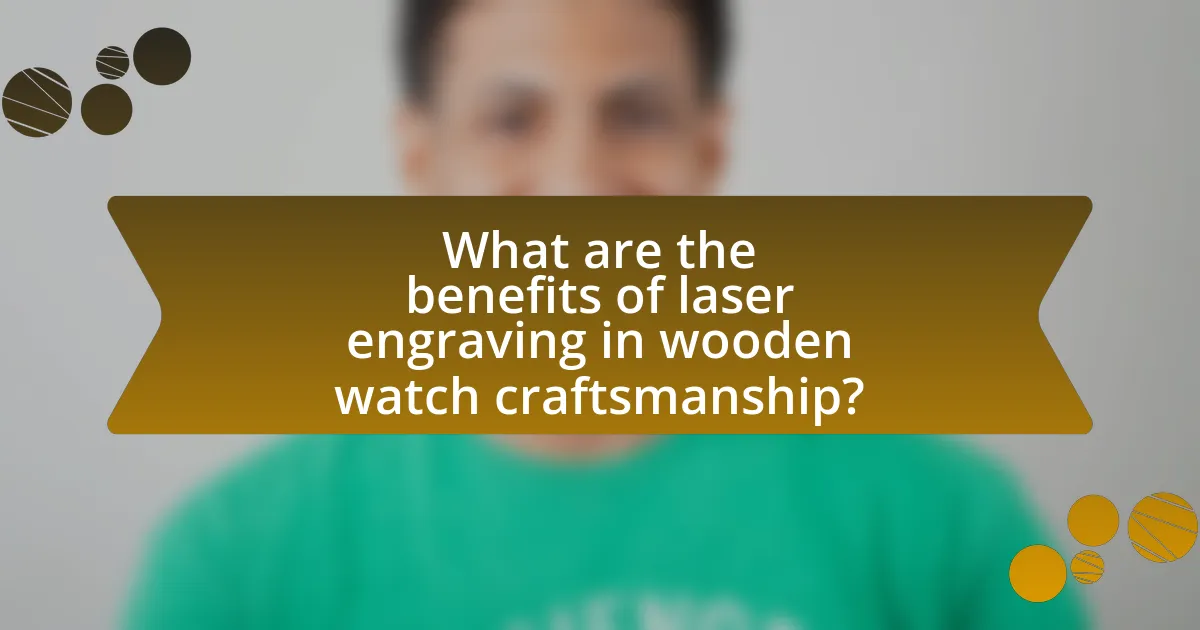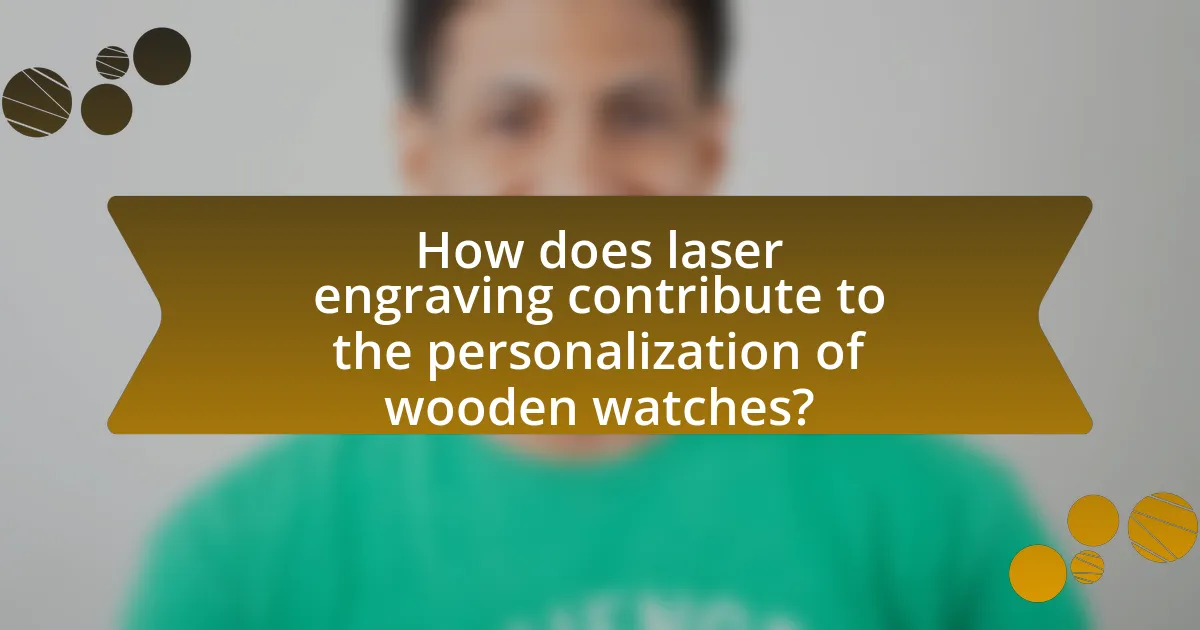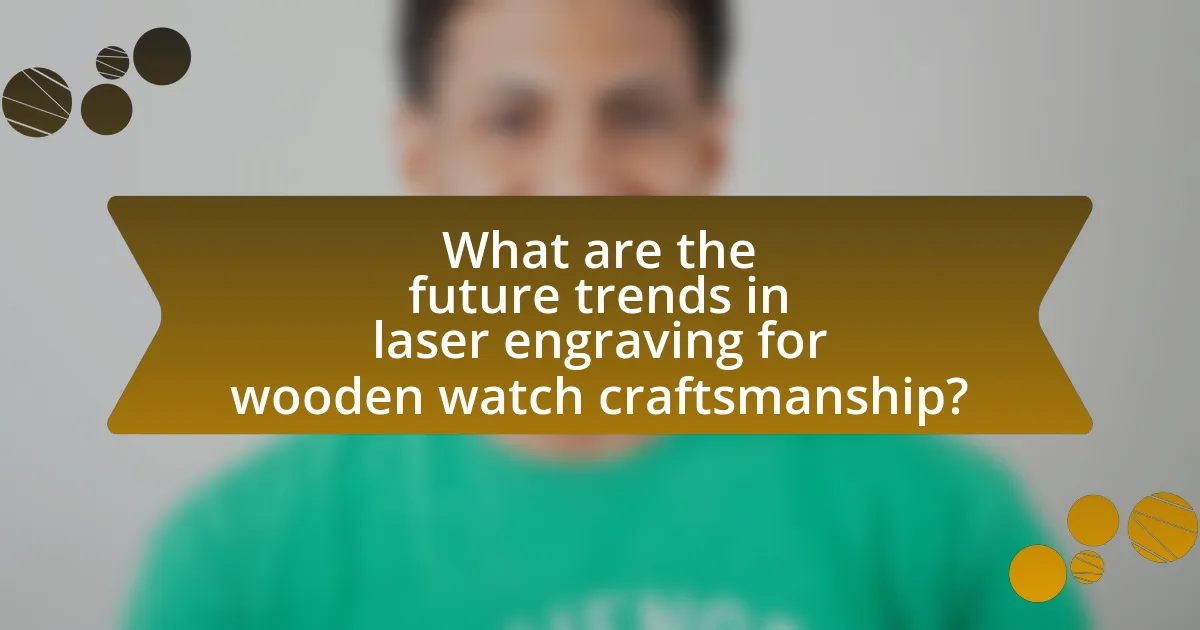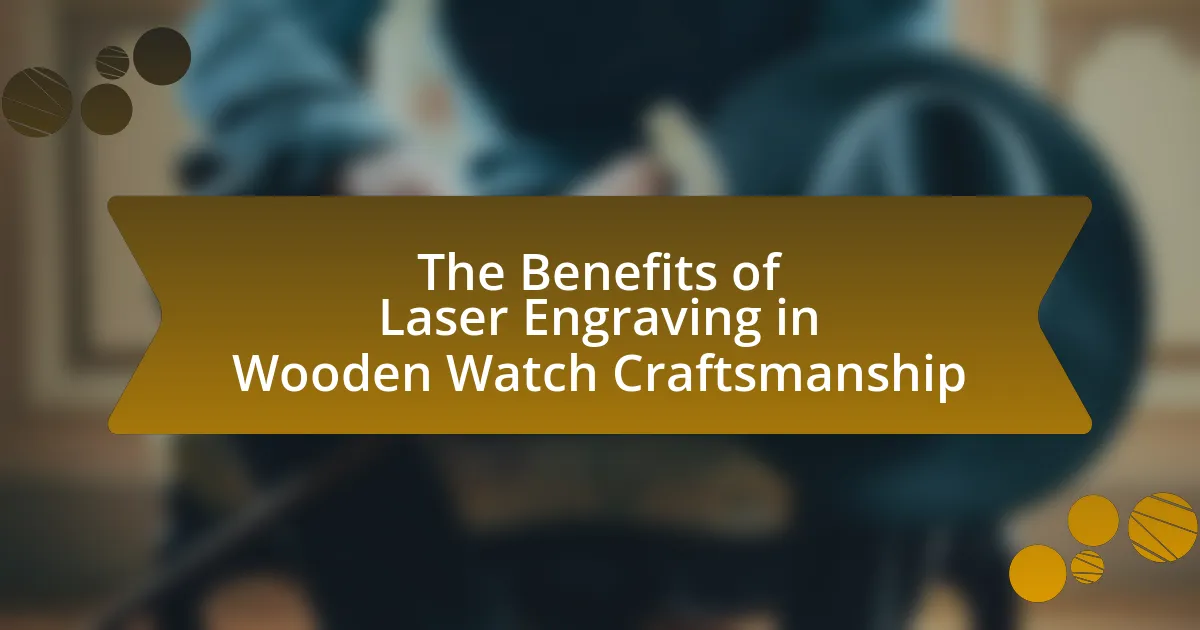Laser engraving is a transformative technology in wooden watch craftsmanship, offering benefits such as precision, customization, and durability. This method allows artisans to create intricate designs and personalized engravings that enhance the aesthetic appeal of watches while preserving the integrity of the wood. The article explores how laser engraving improves design precision, reduces material waste, and increases product longevity, making it a preferred choice over traditional engraving methods. Additionally, it highlights the impact of personalization on customer satisfaction and the future trends in laser engraving technology that promise to further elevate craftsmanship in the wooden watch industry.

What are the benefits of laser engraving in wooden watch craftsmanship?
Laser engraving in wooden watch craftsmanship offers precision, customization, and durability. The technology allows for intricate designs and detailed personalization that traditional methods cannot achieve, enhancing the aesthetic appeal of the watches. Additionally, laser engraving is less invasive, preserving the integrity of the wood while ensuring that the engravings are permanent and resistant to wear over time. This method also reduces production time and costs, making it more efficient for artisans. Studies indicate that laser engraving can increase product value by up to 30% due to its unique and personalized nature, appealing to consumers seeking distinctive items.
How does laser engraving enhance the design of wooden watches?
Laser engraving enhances the design of wooden watches by providing intricate and precise detailing that is difficult to achieve through traditional methods. This technology allows for customization options, enabling unique patterns, logos, or text to be etched onto the wood surface, which personalizes each watch and adds aesthetic value. For instance, laser engraving can create fine lines and complex designs with a level of accuracy that ensures the integrity of the wood is maintained, resulting in a visually appealing product that stands out in the market. Additionally, the durability of laser-engraved designs ensures that the details remain intact over time, further enhancing the overall craftsmanship of the wooden watch.
What unique design possibilities does laser engraving offer?
Laser engraving offers unique design possibilities such as intricate detailing, precision customization, and the ability to create complex patterns on various materials. This technology allows artisans to engrave fine lines and detailed images that would be difficult or impossible to achieve with traditional methods. For instance, laser engraving can produce high-resolution designs, including logos and personalized text, directly onto wooden surfaces, enhancing the aesthetic appeal of wooden watches. The precision of laser engraving ensures that designs are consistent and reproducible, making it ideal for creating limited edition pieces or personalized gifts.
How does laser engraving improve precision in watch designs?
Laser engraving improves precision in watch designs by utilizing focused laser beams to create intricate details with high accuracy. This technology allows for the engraving of fine lines and complex patterns that traditional methods cannot achieve, ensuring that every element of the watch, from logos to serial numbers, is precisely rendered. Studies have shown that laser engraving can achieve tolerances as tight as 0.01 mm, significantly enhancing the overall quality and aesthetic appeal of the timepiece.
Why is laser engraving preferred over traditional engraving methods?
Laser engraving is preferred over traditional engraving methods due to its precision and efficiency. Unlike traditional methods, which can be labor-intensive and less accurate, laser engraving utilizes focused light beams to create intricate designs with high detail and minimal material waste. This technology allows for faster production times, enabling artisans to complete projects more quickly while maintaining high-quality standards. Additionally, laser engraving can easily be automated, further enhancing productivity and consistency in wooden watch craftsmanship.
What are the advantages of speed and efficiency in laser engraving?
Speed and efficiency in laser engraving provide significant advantages, including reduced production time and increased output quality. Faster engraving processes allow artisans to complete projects in less time, which enhances productivity and enables the handling of larger orders. Additionally, efficient laser systems minimize material waste by precisely targeting the engraving area, resulting in cost savings and improved sustainability. According to a study by the International Journal of Advanced Manufacturing Technology, laser engraving can achieve speeds up to 10 times faster than traditional methods, demonstrating its effectiveness in enhancing craftsmanship in wooden watch production.
How does laser engraving reduce material waste in craftsmanship?
Laser engraving reduces material waste in craftsmanship by utilizing precise, computer-controlled technology that minimizes excess material removal. Unlike traditional methods, which often involve cutting or carving that can lead to significant waste, laser engraving focuses on exact specifications, allowing artisans to create intricate designs with minimal leftover material. Studies indicate that laser engraving can achieve up to 90% material efficiency compared to conventional techniques, as it only removes the necessary material for the design without compromising the integrity of the remaining piece. This efficiency not only conserves resources but also lowers production costs, making it a sustainable choice in craftsmanship.
What impact does laser engraving have on the durability of wooden watches?
Laser engraving enhances the durability of wooden watches by creating precise, shallow markings that do not compromise the structural integrity of the wood. This technique minimizes the risk of splintering or cracking compared to traditional engraving methods, which often involve deeper cuts. Additionally, laser engraving can be performed with high precision, ensuring that the wood’s surface remains intact and protected from wear and tear. Studies indicate that laser-engraved surfaces can resist moisture and environmental factors better, contributing to the longevity of the watch.
How does laser engraving affect the longevity of the engraved designs?
Laser engraving significantly enhances the longevity of engraved designs by creating precise, permanent markings on the material. This method utilizes high-intensity lasers to remove material, resulting in deep engravings that are less susceptible to wear and fading compared to traditional engraving methods. Studies indicate that laser-engraved designs can withstand environmental factors such as moisture, UV exposure, and abrasion, which often degrade other forms of engraving. For instance, a comparison of engraving techniques published in the Journal of Materials Processing Technology demonstrates that laser engraving maintains clarity and detail over time, ensuring that designs remain visible and intact for years.
What protective qualities does laser engraving provide to wooden surfaces?
Laser engraving provides enhanced durability and resistance to environmental factors for wooden surfaces. The process creates a permanent mark that penetrates the wood, which helps protect against moisture, UV light, and physical wear. This is particularly beneficial in wooden watch craftsmanship, where exposure to sweat and varying temperatures can degrade the material. Additionally, laser engraving can seal the wood’s surface, reducing the likelihood of splintering and damage over time, thus extending the lifespan of the product.

How does laser engraving contribute to the personalization of wooden watches?
Laser engraving significantly enhances the personalization of wooden watches by allowing for intricate and precise designs to be etched onto the surface. This technology enables customers to add names, dates, or custom graphics, making each watch unique to the individual. The precision of laser engraving ensures that the details are sharp and clear, which is essential for creating meaningful and aesthetically pleasing personalization. Additionally, the process is efficient and can be completed quickly, allowing for a wide range of customization options without compromising quality.
What customization options are available through laser engraving?
Laser engraving offers a variety of customization options, including personalized text, intricate designs, logos, and images on wooden surfaces. This technology allows for precise detailing, enabling artisans to create unique patterns and engravings that enhance the aesthetic appeal of wooden watches. The versatility of laser engraving ensures that each piece can be tailored to individual preferences, making it possible to commemorate special occasions or reflect personal style.
How can customers personalize their wooden watches with laser engraving?
Customers can personalize their wooden watches with laser engraving by selecting specific text, symbols, or designs to be etched onto the watch surface. This process utilizes advanced laser technology, which allows for precise and intricate engravings that can include names, dates, or custom graphics. The accuracy of laser engraving ensures that the personalization is durable and maintains the aesthetic quality of the wood, making it a popular choice for gifts and commemorative pieces.
What are the trends in personalized wooden watch designs using laser engraving?
Trends in personalized wooden watch designs using laser engraving include intricate custom patterns, personalized messages, and the use of eco-friendly materials. The rise of consumer demand for unique, individualized products has led artisans to adopt advanced laser engraving techniques that allow for detailed designs and personalization options. For instance, many brands now offer the ability to engrave names, dates, or meaningful symbols directly onto the watch face or band, enhancing emotional value. Additionally, the trend towards sustainability has prompted the use of responsibly sourced wood, which can be effectively engraved with precision, ensuring both aesthetic appeal and environmental consciousness.
Why is customer engagement important in wooden watch craftsmanship?
Customer engagement is crucial in wooden watch craftsmanship because it fosters a deeper connection between artisans and consumers, enhancing brand loyalty and driving sales. Engaged customers are more likely to appreciate the craftsmanship and unique qualities of wooden watches, which often include personalized elements like laser engraving. Research indicates that brands with high customer engagement can see a 23% increase in profitability, as engaged customers tend to make repeat purchases and recommend products to others. This interaction not only helps artisans understand customer preferences but also allows for the incorporation of feedback into future designs, ultimately improving product offerings and customer satisfaction.
How does personalization through laser engraving enhance customer satisfaction?
Personalization through laser engraving enhances customer satisfaction by creating unique, tailored products that resonate with individual preferences. This customization allows customers to express their identity or commemorate special occasions, leading to a deeper emotional connection with the product. Studies indicate that personalized items can increase perceived value and customer loyalty, as consumers are more likely to appreciate and cherish products that reflect their personal stories or relationships. For instance, a survey by Deloitte found that 36% of consumers expressed interest in purchasing personalized products, highlighting the demand for such customization in the market.
What role does storytelling play in the personalization of wooden watches?
Storytelling plays a crucial role in the personalization of wooden watches by creating emotional connections between the product and the consumer. This connection enhances the perceived value of the watch, as customers often seek unique narratives that resonate with their personal experiences or values. For instance, a watch engraved with a meaningful date or message can evoke memories and sentiments, making it more than just a timepiece. Research indicates that products with a story behind them can increase consumer engagement and loyalty, as storytelling fosters a sense of belonging and identity. Thus, the integration of storytelling in the personalization process not only enriches the customer experience but also drives brand differentiation in the competitive wooden watch market.

What are the future trends in laser engraving for wooden watch craftsmanship?
Future trends in laser engraving for wooden watch craftsmanship include increased precision, customization options, and the integration of advanced technology such as artificial intelligence. The precision of laser engraving allows for intricate designs that enhance the aesthetic appeal of wooden watches, while customization options enable consumers to personalize their timepieces, catering to individual tastes. Additionally, the incorporation of AI can streamline the design process, allowing for rapid prototyping and adjustments based on consumer feedback. These trends are supported by the growing demand for unique, handcrafted products in the luxury market, which emphasizes personalization and quality craftsmanship.
How is technology evolving in the field of laser engraving?
Technology in the field of laser engraving is evolving through advancements in precision, speed, and versatility. Modern laser engraving machines now utilize fiber and CO2 lasers, which provide higher accuracy and can engrave a wider range of materials, including wood, metal, and glass. For instance, the introduction of computer numerical control (CNC) technology has enabled automated and intricate designs, significantly reducing production time and increasing design complexity. Additionally, software improvements allow for more sophisticated design capabilities, enabling artisans to create detailed and customized engravings that enhance the aesthetic appeal of wooden watches. These advancements are supported by industry reports indicating a growing demand for personalized products, which laser engraving effectively meets.
What innovations are being introduced in laser engraving techniques?
Innovations in laser engraving techniques include advancements in fiber laser technology, which enhances precision and speed, allowing for intricate designs on wooden surfaces. Additionally, the integration of artificial intelligence in engraving software enables automated design adjustments and optimizations, improving efficiency and reducing material waste. These innovations are supported by studies showing that fiber lasers can achieve engraving speeds up to 10 times faster than traditional CO2 lasers, while AI-driven systems can reduce design errors by over 30%, thereby increasing overall productivity in wooden watch craftsmanship.
How might future advancements impact the craftsmanship of wooden watches?
Future advancements, particularly in laser engraving technology, will significantly enhance the craftsmanship of wooden watches by allowing for more intricate and precise designs. This technology enables artisans to create detailed patterns and customizations that were previously difficult or impossible to achieve with traditional methods. For instance, laser engraving can achieve resolutions of up to 1200 DPI, which allows for fine details and complex designs that enhance the aesthetic appeal of wooden watches. Additionally, advancements in sustainable materials and eco-friendly finishes will improve the durability and longevity of wooden watches, ensuring they remain competitive in the luxury watch market. These innovations not only elevate the craftsmanship but also align with consumer preferences for personalized and environmentally responsible products.
What best practices should artisans follow when using laser engraving?
Artisans should follow several best practices when using laser engraving to ensure high-quality results and efficient processes. First, they must select the appropriate material for engraving, as different woods react differently to laser settings; for instance, hardwoods like maple provide cleaner engravings compared to softer woods. Second, artisans should calibrate their laser settings, including power, speed, and frequency, based on the material thickness and type to achieve optimal engraving depth and clarity.
Additionally, maintaining the laser machine is crucial; regular cleaning of lenses and mirrors prevents residue buildup that can affect engraving quality. Artisans should also conduct test engravings on scrap material to fine-tune settings before working on final pieces, ensuring the desired outcome. Finally, using design software that supports vector graphics allows for precise and scalable designs, enhancing the overall quality of the engraving. These practices are supported by industry standards that emphasize the importance of material selection and machine maintenance for achieving professional results in laser engraving.
How can artisans ensure quality and consistency in their laser engraving work?
Artisans can ensure quality and consistency in their laser engraving work by implementing standardized processes and utilizing high-quality materials. Standardized processes include setting specific parameters for laser settings such as speed, power, and frequency, which can be documented and replicated across different projects. High-quality materials, such as premium wood types, contribute to better engraving results, as they respond more predictably to laser engraving. Additionally, regular maintenance of the laser engraving equipment ensures optimal performance, reducing the likelihood of errors that can affect quality. These practices collectively lead to a more reliable output, as evidenced by industry standards that emphasize the importance of consistency in craftsmanship for customer satisfaction.
What common challenges do artisans face with laser engraving, and how can they be overcome?
Artisans face several common challenges with laser engraving, including material compatibility, precision control, and equipment maintenance. Material compatibility issues arise when certain woods or finishes do not engrave well, leading to poor quality results; this can be overcome by conducting tests on various materials to identify the best options for engraving. Precision control challenges occur when settings are not optimized for specific designs, which can be addressed by using software that allows for detailed adjustments and previews before engraving. Equipment maintenance is crucial, as neglect can lead to decreased performance; regular cleaning and calibration of the laser engraver can mitigate this issue, ensuring consistent quality in the engraving process.
